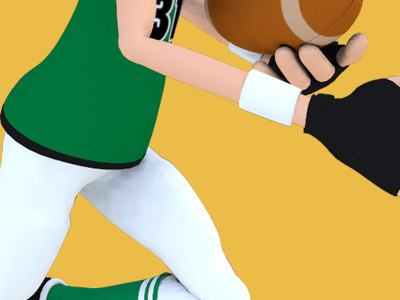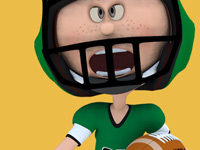American football

American Football Huddle
In sport, a huddle is an action of a team gathering together, usually in a tight circle, to strategize, motivate or celebrate. It is a popular strategy for keeping opponents insulated from sensitive information, and acts as a form of insulation when the level of noise in the venue is such that normal on-field communication is difficult. Commonly the leader of the huddle is the team captain and it is the captain who will try to inspire his fellow team members to achieve success. Similarly after an event a huddle may take place to congratulate one another for the teams success, or to commiserate a defeat. The term "huddle" can be used as a verb as in "huddling up".
Types
Circular
The modern-day circular huddle, in which the players all face inward in a tight circle, was invented by Gallaudet University quarterback Paul D. Hubbard in 1892. Gallaudet was among the first schools intended for the education of deaf and hard-of-hearing students, and the first intended for their postsecondary education. When quarterbacking, Hubbard realized that his hand signals could be read by opposing players, a particular concern when Gallaudet played other schools for the deaf. To remedy this, he had his players form a circle so that his sign-language signals could be sent and received without anyone on the sidelines or on the opposing team seeing.
This type of huddle is still in common use today, typically between plays in American Football as the quarterback assigns the next play to the offense.
Typewriter
The typewriter huddle is a huddle formation created by former Florida State Head Coach Tom Nugent in the mid-1950s. It is typically used between a coach and multiple players, or when a quarterback or other player wants to create an image of being separate from the team, dictating to them, rather than being a part of the group, as with the circular huddle. The players being spoken to are arranged in two or more rows, the front row often kneeling or crouching. The player or coach speaking can then be assured that he has the attention of the entire audience, something that often is not possible if that person is in the center of a circular huddle. Though allowing players breathing room and providing space for more participants than a circular huddle, it is not as secure, as observers on the sidelines may be able to see hand signals or read the speaker's lips.
American football
In American football, though seemingly random, huddles can have several forms. Before the 1890s, football players didn’t form huddles; they instead discussed the play far enough from the other team that they could not be overheard. As American football became more organized and formalized, so too did the huddle.
The football team at Oregon Agricultural College was one of the very first schools nationally to use the huddle formation in a game. It happened against the University of Washington in Seattle during the 1918 season. Head coach Bill Hargiss instructed the starters that once they returned to the field, they were to stand 10 yards behind the ball before the beginning of each play and whisper to one another what they were going to do next. An eyewitness to the game was veteran Seattle sports columnist Royal Brougham, whose stories of the contest give testimony today to the program's early use of this pioneering new formation. Others trace the huddle to the 1890s in Gallaudet College.
Another instance of its use was when the huddle was formed by Paul Hubbard, a deaf player who went to Gallaudet University in Washington, D.C. To avoid having the other team see his sign language between plays, he and his team huddled to conceal the signs.
During a game, the quarterback uses the huddle to communicate the next play to the offense. National Football League Rule 5 Section 2 stipulates that no more than eleven players may be in the offensive huddle. An offensive substitute who communicates with a teammate in a huddle would be penalized for "unsportsmanlike conduct"; this is to prevent teams from feigning a substitution and taking advantage of the chaos to confuse opponents.
In some situations, teams may chose not to call a huddle and employ a hurry-up no-huddle offense to maximize time and surprise the defense.
Snap (gridiron football)
In a snap, the snap count is decided on in the huddle, usually expressed as "...on <number>." being the final words spoken by the quarterback after calling the play but before the huddle breaks and the players go to the line of scrimmage. The snap count allows offensive players to have a small head start.
SPORTS



American Football
Game play in American football consists of a series of downs, individual plays of short duration, outside of which the ball is dead or not in play. These can be plays from scrimmage – passes, runs, punts, or field goal attempts (from either a place kick or a drop kick) – or free kicks such as kickoffs and fair catch kicks. Substitutions can be made between downs, which allows for a great deal of specialization as coaches choose the players best suited for each particular situation. During a play, each team should have no more than 11 players on the field, and each of them has specific tasks assigned for that specific play.
Rules and gameplay
- Scoring
- Maneuvers
- Strategy
- Play types
- Penalties
- Turnovers
- Downs
- Teams and positions
- Field
- Equipment
- Duration and time stoppages
- Advancing the ball and downs
- Kicking
- Officials and fouls
Positions
Offensive (Interior) line
Backs and receivers
Defensive line
Linebackers
Defensive backs
Special teams
- Kicker (K)
- Holder (H)
- Long snapper (LS)
- Punter (P)
- Kickoff specialist (KOS)
- Kick returner (KR) and Punt returner (PR)
- Upback
- Gunner
- Jammer


RESOURCES
This article uses material from the Wikipedia articles "American football", "American football rules", "Huddle", which is released under the Creative Commons Attribution-Share-Alike License 3.0.
© Stories Preschool. All Rights Reserved.





